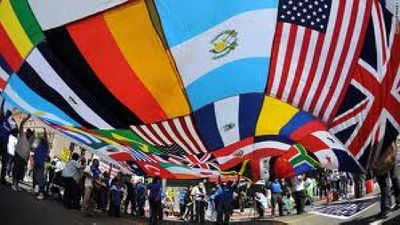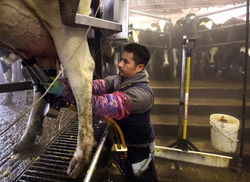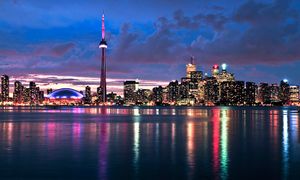Impact of Immigration laws on Society
Immigration is the movement of people into one country from another for settlement; hence, immigrants are people who arrive in a country intending their stay to be more than temporary. For example, the UK government describes ‘long-term international migrants’ as people who, on arrival, state an intention to make the country their usual residence for at least a year. But these intentions may not be realized. Not everyone arriving this way is considered a foreigner or subject to immigration control; children born abroad to UK citizens (such as the armed forces) are not counted as immigrants[1]. As a country recognized for its multiculturalism, Canadian history tends to overlook the founding governing body of race and immigration, which helped shape the geography of Canada. Some of the themes presented by Western Policy maker’s demonstrated acts of systemic oppression against non-white ethnic groups through acts of racism and immigration. This was for the purpose of preserving the “white” racial and ethnic make up of the Country. Such forms of power can be associated with systems of knowledge aimed at governing population, and how the government constructs other ethnic groups as a threat to public order.

Illegal Immigration
The movement into a country by persons in violation of that country’s immigration, visa, and/or residence laws, either through clandestine entry or over-staying, i.e. exceeding the terms of a visa granted for another purpose such as study or tourism. Many analysts prefer the less pejorative terms ‘undocumented’ or ‘irregular’ migration, implying that such immigrants are not criminals but may also be victims of poverty, displacement, and coercive or unjust state practices[2] Immigration is selective in at least two senses. The particular individuals who migrate may be differentiated by skill, age, gender, race, health, etc. In addition, states increasingly try to select what kinds of people they will admit for different categories of residence, study, and labour (see skilled migration). The interaction between these two kinds of selection may result in distinct ‘migration channels’, in which intermediaries such as recruitment agencies play a role in shaping who can move and how (Findlay and Li 1998).
Skilled Migration
The movement between countries of high-skilled or trained individuals for permanent or temporary settlement; sometimes termed ‘skills migration’. Since the late 20th century, many states have devised specific immigration visas to attract individuals with skills specifically in shortage in the economy, or high levels of skill and education generally. Immigration is also spatially selective, in that incomers rarely match the distribution of the resident population. Whereas immigrants from the Old World colonizing the New World in the 19th century often settled in agrarian regions, most modern-day immigrants head for cities, especially larger metropolitan areas[3]
LCP
Other forms of skilled migration can be seen under Canada's Live-in Caregiver Program or LCP, which offers a chance a permanent residency if nannies under the LCP program are able to demonstrate two years of full time employment over a three year period.

No other country offers this emigrating opportunity to Filipino caregivers, while also providing better work conditions than most other countries. [4]
Stated by the national post, as many as 100,000 Filipino women have been accepted into the LCP since the early 1990s. This represents nearly 90% of any nationality in the program. At its high, more than 10,000 Filipino women were arriving in the LCP annually, but that figure has dropped to about 6,000, a decline mostly attributed to a lack of need, says Filipino-Canadian activist Cecilia Diocson, founder of the Philippine Women’s Centre of B.C. There are now many former Filipino LCP caregivers with citizenship occupying the jobs their foreign worker counterparts once took. “The entire Filipino community in Canada numbers about 400,000. Most can trace their immigration to the LCP, either as direct applicants or family,” says Diocson.[5]
Gateway City
A city that serves as a point-of-entry to a geographical region, usually in terms of migration. New York, Sydney, and Toronto are all gateway cities in that tens of thousands of immigrants arrive in their respective countries via the airports and ports of those cities. But St Louis, Missouri is equally a gateway to the western USA for traffic from the east crossing the Mississippi river.[6]
Immigration Laws
In Canadian immigration and refugee law, enforcement is done through the CIC/IRCC also known as the Citizenship and Immigration Canada which was changed to Immigration, Refugee and Citizenship Canada as of November, 2015, becoming more apparent over the opening weeks of 2016. Important to note is that CIC and IRCC are the same departments. Documents or publications referring to CIC in one instance and IRCC in another are actually referring to the same department. The addition of the word ‘refugees’ in the official name of the government department reflects the current government’s focus on humanitarian and refugee immigration to Canada.[7]
CIC/IRCC
The purpose of IRCC is to strengthen Canada’s economic, social and cultural prosperity by helping ensure Canadian safety and security. This is done by offering protection to refugees while the IRCC further develops Canada’s admissibility policy, which sets the conditions for entering and remaining in Canada. Fundamentally, the Department builds a stronger Canada by helping immigrants and refugees settle and fully integrate into Canadian society and the economy, and by encouraging and facilitating Canadian citizenship. The IRCC also claimed responsibility in 2008 for administering the Canadian multiculturalism act, as well as responsibility for the administration of canadian passport order. Authority for the IRCC is given by the department of citizenship and immigration act.[8]
Health Care Provided
Each province, territory, state, country, has their own health insurance plan and policy made to accommodate their specific population. While all provinces and territories provide free emergency medical services even if you do not have government health card, restrictions may apply depending on your immigration status. If you go to a walk in clinic in a province or territory where you are not a resident, you ma be charged a fee. The Interim Federal Health Program IFHP provides temporary health insurance to refugees, protected persons, refugee claimans, and their dependants who arent eligible for provincial or territorial (PT) health insurance[9]

The Interim Federal Health Program IFHP provides temporary health insurance to refugees, protected persons, refugee claimans, and their dependants who arent eligible for provincial or territorial (PT) health insurance
- IFHP Basic Coverage
- In patient and out of patient hospital services
- Services from medical doctors, registered RNs, pre and post natal care, and other health care professionals licensed in Canada
- Laboratory, diagnostic and ambulance services[10]
CHC
Other health care services like CHC community health centres have been created in places like scaborough, Ontario, in response to large numbers of immigrants and refugees residing in that community who have been denied access to publicly funded health care. With two centres being established as of May 2000, the volunteer health clinic has provided free health care to vulnerable groups, with a recorded 20 thousand plus patient visits. Ontario, Quebec and British Columbia enforce a 3-month wait for health insurance for Canadas landed immigrants. Upon the changes made to the IFHP, Canadas refugee claimants all received coverage upon arrival, despite 65% of those claims being rejected.[11]
Economic Effects of Immigration
Multiple studies show there is no link between immigrants migration to the direct effect on the average north american economic wages over the long term and that migration has mostly a positive effect on the economy. More evidence points to how immigration leads to "more innovation, better educated workforce, greater occupational specialization, better matching of skills with jobs, and higher overall economic productivity."[12] Although immigration has a net positive effect on federal, state and local budgets, regions with large populations of less, low income immigrants result in native-born residents having to bear the significant net cost, due to immigrants use of public services, specifically education.

Many secondary market jobs are filled by undocumented laborers because they usually involve harsh working conditions that few native born workers are willing to accept. Immigrants arrive as substitutes for menial jobs in which regular civilians don’t want to do, they do not compete or the same jobs and put minimal downward pressure on native wages.
- Examples can be seen from NY dairy market, where 1/3 of all US dairy farms employ foreign born workers, producing nearly 80% nations milk[13]
A staggering statistic report done by NMPF by Texas AgriLife Reseaerch at Texas A&M University, represented on the agweb.com article was that, " Researchers estimated that 150,418 employees worked on U.S. dairy farms in 2013, and that 51 percent of them, or 76,968, were immigrants". With this evidence, we can predict total loss of immigrant labor would reduce the size of both the U.S. dairy herd and the nation’s milk production by nearly a quarter. More than 7,000 dairy farms would close.[14]
Sanctuary Cities
In response to current political shifts in North America, cities have deemed themselves Sanctuary Cities. This was for the purpose of allowing illegal immigrants to be able to have access to certain health benefits, work and educational benefits. By doing this, Sanctuary Cities don’t have to agree to immigration law, allowing immigrants the right to refuse being questioned in public by law enforcement. Currently, there are approximately 300 across Canada and US, with Toronto being the first Canadian one.
Toronto was first city in Canada to become one, followed by Hamilton, and Montreal. As of February 2017, Calgary, Ottawa, Regina, Saskatoon and Winnipeg consider themselves sanctuary cities. In Toronto for example, services are made accessible to all residents, despite their immigration status, where the organizations and agencies involved with helping have confirmed to keep non-status immigrants information confidential except where Canadian law requires otherwise.[15]

- Services provided
- Police, fire, ambulance services - 911
- Telehealth ontario
- Toronto Community Health Centre
- Toronto District School Board
- Ontario Early years Centres
- Workers Action Centre[16]
Although Vancouver has yet to become a Sanctuary City, the city has adopted policies which allow individuals and families of illegal-status to have access to certain services. Not all services are provided, excluded from the list are municipal services operated by individual board such as the police, public library, and park board. This new found services is referred to as the "Access to city services without fear" policy for residents who are undocumented or have uncertain immigration status.
ShaquilleRandalDavisRamlochan (talk)
References
- ↑ Castree, Noel. "Immigration - Oxford Reference." Immigration - Oxford Reference. Oxford University Press, 01 Feb. 2017. Web. 05 Apr. 2017.
- ↑ Castree, Noel. "Illegal Immigration - Oxford Reference." Illegal Immigration - Oxford Reference. Oxford University Press, 01 Feb. 2017. Web. 05 Apr. 2017.
- ↑ Castree, Noel. "Skilled Migration - Oxford Reference." Skilled Migration - Oxford Reference. Oxford University Press, 01 Feb. 2017. Web. 05 Apr. 2017.
- ↑ Post, Susan McClelland National. "Susan McClelland on Nannies from the Philippines: Suffer the Caregiver." National Post. N.p., 24 Jan. 2014. Web. 09 Apr. 2017.
- ↑ "Acts and Regulations." Government of Canada, Immigration, Refugees and Citizenship Canada, Communications Branch. N.p., 15 Feb. 2016. Web. 05 Apr. 2017.
- ↑ Castree, Noel. "Gateway City - Oxford Reference." Gateway City - Oxford Reference. Oxford University Press, 01 Feb. 2017. Web. 05 Apr. 2017.
- ↑ Branch, Legislative Services. "Consolidated Federal Laws of Canada, Immigration and Refugee Protection Act." Legislative Services Branch. N.p., 23 Mar. 2017. Web. 05 Apr. 2017.
- ↑ "Acts and Regulations." Government of Canada, Immigration, Refugees and Citizenship Canada, Communications Branch. N.p., 15 Feb. 2016. Web. 05 Apr. 2017..
- ↑ Government of Canada, Immigration, Refugees and Citizenship Canada, Communications Branch. "Health Care – Refugees." Government of Canada, Immigration, Refugees and Citizenship Canada, Communications Branch. N.p., 31 Mar. 2017. Web. 09 Apr. 2017.
- ↑ Caulford, Paul, and Jennifer D'Andrade. "Health Care for Canada's Medically Uninsured Immigrants and Refugees." Canadian Family Physician. The College of Family Physicians of Canada, 01 July 2012. Web. 05 Apr. 2017.
- ↑ Hansen, Denise. "Connect with Your Community!" Canadian Immigrant Site Wide Activity RSS. N.p., 3 Sept. 2013. Web. 05 Apr. 2017..
- ↑ "The Effects of Immigration on the United States' Economy." Penn Wharton Budget Model. N.p., n.d. Web. 05 Apr. 2017.
- ↑ Release, News. "Losing Immigrant Workers on Dairy Farms Would Nearly Double Retail Milk Prices." AgWeb - The Home Page of Agriculture. N.p., 09 Sept. 2015. Web. 05 Apr. 2017.
- ↑ Release, News. "Losing Immigrant Workers on Dairy Farms Would Nearly Double Retail Milk Prices." AgWeb - The Home Page of Agriculture. N.p., 09 Sept. 2015. Web. 05 Apr. 2017.
- ↑ Hansen, Denise. "Connect with Your Community!" Canadian Immigrant Site Wide Activity RSS. N.p., 3 Sept. 2013. Web. 05 Apr. 2017.
- ↑ Hansen, Denise. "Connect with Your Community!" Canadian Immigrant Site Wide Activity RSS. N.p., 3 Sept. 2013. Web. 05 Apr. 2017.